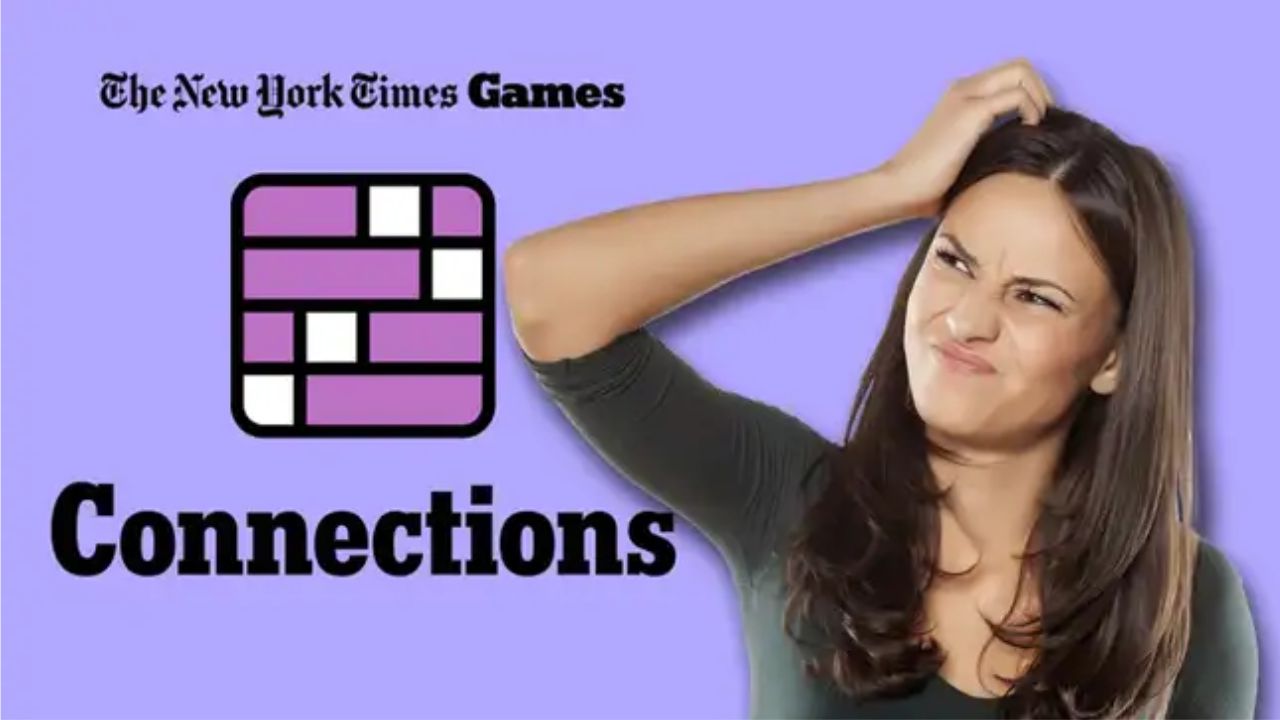Blogs
Mastering the NYT Connections Game: Essential Hints and Strategies

Nyt Connections hint game has become a popular puzzle challenge that invites players to think critically and make meaningful connections between words, objects, or concepts. Like many other games from the New York Times, it draws players in with its seemingly simple design but quickly proves to be far more complex. If you’ve found yourself stuck or scratching your head, you’ve come to the right place. Let’s dive into the best tips and hints for conquering this addictive word puzzle.
What is NYT Connections?
The NYT Connections game is a brain-teasing puzzle that challenges you to group items based on shared connections. These connections could be related to meanings, themes, categories, or even word structures. The goal is to identify these relationships and group the items correctly, making it both a test of vocabulary and logic.
At first glance, it might seem like a breeze, but as the puzzles grow more intricate, so do the connections. It’s essential to approach each puzzle strategically to avoid getting stuck or overwhelmed.
How NYT Connections Works
In every NYT Connections puzzle, players are presented with a grid of words. Your task is to sort the words into categories by finding four distinct groups of four related items. The trick lies in identifying the common thread linking the items within each group. Some connections might be obvious, but others are designed to throw you off track.
For example, if the words are related to animals, colors, or even abstract ideas like emotions or actions, you need to think beyond the literal meaning of each word. You must figure out the subtle ways they could be connected.
NYT Connections Hint: Start with the Obvious
One of the best approaches to solving NYT Connections puzzles is to start with the most obvious words or groupings. When you first see the list, some words will naturally stick out as being part of a particular theme. Start there. For instance, if you see words like “cat,” “dog,” “parrot,” and “goldfish,” it’s safe to assume they all belong to the “Pets” category.
Starting with easy connections helps build momentum, and once you’ve grouped the straightforward items, it becomes easier to decipher the trickier ones.
Pay Attention to Word Ambiguity
NYT Connections loves to challenge players by including words that have multiple meanings or could fit into more than one category. For example, a word like “spring” could refer to a season, a mechanical device, or even a body of water. Always keep in mind the possibility that a word might not mean what you first assume.
By remaining open to different interpretations of a word, you’ll increase your chances of identifying the correct grouping. Also, beware of false connections! Some words might seem to go together at first glance, but after careful thought, you’ll realize they belong in entirely different groups.
Hints for Solving Difficult Puzzles
Once you’ve grouped the most apparent items, you might hit a wall. This is where the following hints come in handy for those more difficult puzzles:
- Cross-referencing categories: Try to think about how categories interact. If you’re stuck, mentally eliminate words from categories you’ve already identified. This way, you narrow down your options and can focus more clearly on what’s left.
- Look for thematic overlap: Sometimes words might seem unrelated until you spot an overarching theme. For example, “wheel,” “rudder,” “pedal,” and “engine” all might appear in different contexts, but they’re all parts of vehicles.
- Think outside the box: Some connections are more abstract than others. Don’t limit your thinking to traditional categories. For instance, if words seem random, try to identify if they’re linked by a specific industry, event, or cultural reference.
Why You Should Take Your Time
Solving the NYT Connections puzzles isn’t about rushing to the finish line; it’s about taking your time to explore potential groupings. If you’re feeling stuck, it can often help to walk away and return with a fresh perspective. The game encourages patience and persistence, and sometimes a quick break is all it takes to see the puzzle in a new light.
Unlike other puzzles, where speed is key, here it’s more important to think critically and creatively. Many of the most satisfying moments come from making an unexpected connection that ties the entire puzzle together.
Common Mistakes and How to Avoid Them
As you play the NYT Connections game, you might encounter some common pitfalls that can slow you down. Here’s how to avoid them:
- Overthinking connections: One of the most common mistakes is over-complicating the relationships between words. Sometimes the connection is much simpler than you think. If you’re spinning your wheels on a potential solution, step back and reassess.
- Ignoring synonyms or related terms: Don’t forget that some connections might not be direct but rather conceptual. Words like “fast” and “quick” might not be obvious at first, but they share a similar meaning. Always consider synonyms or related ideas.
- Forgetting to double-check previous groupings: Sometimes, you may rush to group words together, but in doing so, miss out on a better fit elsewhere. It’s always a good idea to revisit previous groupings to make sure they still hold up as more words are grouped.
NYT Connections Hint: Use a Process of Elimination
One effective strategy for tough puzzles is to use the process of elimination. By removing the words that you’ve already grouped, you shrink the pool of potential answers, making it easier to focus on what’s left. This helps when you’re dealing with those last tricky connections that seem to defy categorization.
After forming a few groups, you can go back to review which words remain. Often, you’ll spot connections that weren’t initially apparent.
Practice Makes Perfect
As with any puzzle game, the more you practice, the better you’ll become at solving NYT Connections. Over time, you’ll start recognizing patterns, common themes, and word groupings more quickly. You may even begin to anticipate the kinds of tricky connections the game throws your way.
A regular routine of playing can sharpen your cognitive abilities, improve your vocabulary, and strengthen your problem-solving skills.
Where to Find Additional Help
If you’re still finding it difficult to crack the NYT Connections puzzles, don’t worry. The New York Times puzzle community is vast and enthusiastic, offering forums, blogs, and discussion threads where you can find insights or hints from fellow players. Just make sure to avoid spoilers if you’re determined to solve the puzzles on your own.
Additionally, many websites and puzzle-solving communities provide gentle hints, giving you just enough direction without outright revealing the answers. This can be an excellent resource when you need a little nudge in the right direction.
Final Thoughts
The NYT Connections puzzle is a delightful mix of wit, strategy, and linguistic knowledge. It tests your ability to think critically, identify subtle relationships, and look at words from different perspectives. By starting with the obvious, remaining patient, and applying strategic techniques like the process of elimination, you can master even the toughest puzzles. While it might be challenging at first, don’t get discouraged. Every puzzle solved is a testament to your growing skills and persistence.
Also Read: Paul Inouye Wife: Everything You Need to Know About His Marriage and Personal Life
FAQs
How do you solve NYT Connections puzzles efficiently?
Focus on grouping the most obvious connections first, and then use a process of elimination to narrow down your options. Look for both literal and abstract relationships between words.
What is the key to mastering NYT Connections?
Patience and practice are key. Start with obvious groupings, be open to multiple interpretations of words, and don’t hesitate to double-check your earlier assumptions.
Can I find hints for NYT Connections online?
Yes, several forums and blogs provide hints without giving away the answers. These resources can be helpful when you’re stuck and need a little guidance.
Why are some NYT Connections puzzles so difficult?
The puzzles increase in difficulty by incorporating more abstract or less obvious connections, requiring players to think creatively and critically about the relationships between words.
What should I do if I can’t solve a puzzle?
If you’re stuck, take a break and return with fresh eyes. Sometimes stepping away can help you see the connections more clearly. You can also seek hints online for additional help.
How often are new NYT Connections puzzles released?
NYT Connections is updated regularly with new puzzles, ensuring that players always have a fresh challenge to tackle.
Blogs
поррозаб: The Ultimate Guide to Origins, Uses, and Benefits

Introduction To поррозаб
поррозаб is a fascinating term whose meaning and application have piqued the curiosity of many. Whether it relates to a specific cultural tradition, a concept, or a practical product, porrozab offers layers of complexity. In this article, we will dive deep into its origins, potential meanings, and explore how it is applied in various fields. If you’re eager to understand the background, uses, and possible benefits of porrozab, you’re in the right place.
What is Porrozab?
поррозаб might not be a widely known word across the globe, but it carries substantial meaning in specific contexts. Depending on the regional or cultural background, the word may refer to a concept, practice, product, or even a philosophy.
Some hypotheses suggest that porrozab is rooted in ancient practices or local terminology tied to craftsmanship or everyday life. Others believe it could involve modern innovations, blending tradition with technology. Its versatility makes it worth exploring, especially if you seek applications across industries like health, art, or lifestyle.
The Origins and Meaning of Porrozab
Where does the word поррозаб come from? While there isn’t extensive documentation about the origins, linguistic evidence hints that it may derive from Slavic, Turkic, or Central Asian languages. Its structure suggests a blend of tradition and modern adaptation, indicating that the term has evolved over centuries.
Porrozab could also have deep cultural relevance, being passed down through generations and continuing to shape various aspects of daily living or craft. Much like folk concepts that remain relevant, porrozab seems to bridge the past and present in meaningful ways.
Porrozab in Everyday Life
поррозаб seems applicable across multiple sectors, whether in daily routines, professional practices, or creative industries. Let’s explore a few areas where porrozab could add value:
- Health and Wellness: Perhaps porrozab refers to a method or technique in relaxation, mental well-being, or even alternative medicine. Traditional practices such as herbal remedies or breathing exercises could align with this concept.
- Craft and Design: If porrozab originates from craftsmanship, it could be linked to handicrafts, artisanal products, or a philosophy of mindful creation.
- Technology and Modern Solutions: It’s also possible that porrozab is associated with innovations or techniques in product design or problem-solving strategies.
In these diverse domains, поррозаб symbolizes practical utility and creative inspiration, suggesting that it could apply broadly across many disciplines.
Benefits of Porrozab
The value of поррозаб lies in its potential to inspire creativity, boost well-being, or encourage efficiency. Below are some hypothetical benefits that porrozab could provide:
- Promotes Creativity: If porrozab connects with artistic or design elements, practicing it could encourage unique solutions or creative breakthroughs.
- Enhances Mental Well-being: As a philosophy, porrozab could focus on relaxation or mindfulness, offering an effective way to handle stress.
- Encourages Sustainability: If tied to craftsmanship, porrozab might emphasize eco-friendly practices, ensuring long-term environmental benefits.
- Increases Productivity: In professional settings, porrozab may provide tools or techniques to enhance work efficiency.
Whether it’s through mental clarity, creative insights, or sustainable practices, поррозаб offers a framework for holistic living and innovation.
Porrozab in Modern Contexts
As times evolve, many ancient practices find new relevance. Porrozab could align with contemporary trends in mental health, slow living, or even technology.
Imagine using the principles of porrozab to design eco-friendly products or cultivate a healthier work environment. It could also play a role in minimalism and sustainable lifestyles, reminding us to value simplicity and mindfulness.
How to Incorporate Porrozab into Your Life
If you wish to integrate the concept of porrozab, here are some ideas:
- Practice Mindful Craftsmanship: Dedicate time to creating something by hand, focusing on the joy of the process rather than the end product.
- Embrace Slow Living: Reduce unnecessary tasks and engage with life in a more thoughtful, relaxed way.
- Use Technology Wisely: Incorporate digital solutions only where they enhance your quality of life without overwhelming you.
- Stay Curious and Open-minded: Porrozab could be a concept that grows with you, expanding its meaning as you learn and explore new perspectives.
Conclusion
Porrozab stands as a versatile and meaningful concept, hinting at practical and philosophical significance. Though its origins may be mysterious, its potential applications span multiple areas, including mental wellness, sustainable living, and creative industries. If you’re intrigued by the blend of tradition and modernity, porrozab might be the ideal philosophy to explore.
In a fast-paced world, porrozab reminds us to pause, reflect, and engage meaningfully with life and work. Whether you wish to integrate it into your personal routine or professional space, the opportunities are endless. Embrace porrozab to cultivate mindfulness, creativity, and sustainability in everything you do.
Also Read: Mastering the NYT Connections Game: Essential Hints and Strategies
FAQs
What is porrozab?
Porrozab is a concept that may refer to a practice, philosophy, product, or idea, potentially linked to traditional and modern applications.
Where does the word porrozab come from?
It is likely rooted in Slavic, Turkic, or Central Asian traditions, though its exact origins remain unclear.
How can porrozab be applied today?
Porrozab can be incorporated into creative work, mental wellness routines, and sustainable practices.
Does porrozab have health benefits?
If porrozab involves relaxation techniques or mindfulness, it may promote mental well-being and reduce stress.
Is porrozab related to any specific industry?
Porrozab seems versatile, finding potential use in art, design, technology, and health sectors.
How can I begin practicing porrozab?
Start by focusing on mindful activities—whether through crafting, slowing down your routine, or embracing sustainable habits.
Blogs
10 Expert Connections hint That Will Transform Your Relationships
Blogs
Connections nyt: A Puzzle Game Revolution by The New York Times

What Is Connections NYT?
Each puzzle presents a grid of sixteen words, and your goal is to find four sets of connected words, with each set containing four words. The tricky part? Some words may fit multiple categories, so choosing the right groupings requires careful thought and strategy.
How to Play Connections NYT
To understand Connections nyt, you need to grasp the basic mechanics of the game. When you first open a puzzle, you are presented with a 4×4 grid of 16 words. Your task is to identify four distinct groups of words, with each group consisting of four words that share a common connection. But here’s the kicker—some words can belong to multiple groups, so making the correct associations is key.
For example, in one puzzle, you might have the words “Apple,” “Samsung,” “Tesla,” and “Sony.” These words could all fit into the category of “Tech Companies,” but other possibilities might come into play, such as product lines or industries. The fun (and often frustration) comes from determining the correct pattern of connections.
You must group the words carefully by selecting four that seem related and checking if they form a valid connection. If they do, that group is marked complete, and you move on to finding the next. But guess wrong, and you may quickly find yourself rethinking your approach.
Why Connections NYT is so Addictive
Connections nyt stands out because it isn’t just a test of vocabulary but also of creativity and lateral thinking. The joy of solving a puzzle lies in discovering the subtle connections between seemingly unrelated words. For example, words might be related through categories such as:
- Colors
- Brands
- Historical events
- Genres
- Synonyms or antonyms
This complexity keeps players coming back daily, as no two puzzles feel alike. Each day’s challenge brings a fresh set of words and a new opportunity to flex your mental muscles.
The game offers both satisfaction and frustration—when you finally crack the puzzle, you get a euphoric rush of accomplishment. And when you get stuck, the puzzle teases your brain into re-examining everything you thought you knew. It’s this balance between challenge and reward that makes Connections NYT so addictive for players of all ages.
The Appeal of Word Puzzles in Modern Culture
Why do word puzzles like Connections nyt capture the attention of so many? There’s no denying that in the fast-paced world of social media and short-form content, people are also craving slow, thought-provoking activities. Word games like the ones offered by The New York Times are not only a source of entertainment but also serve as mental workouts.
Cognitive studies show that engaging with puzzles enhances brain activity, improves memory, and sharpens critical thinking skills. For many, playing puzzles like Connections NYT is not just about passing the time but actively improving mental agility.
Moreover, the simplicity of Connections NYT means it’s accessible to a wide audience. Anyone with a love for words, problem-solving, and challenges can dive in, no matter their age or skill level.
Daily Challenges and Community Engagement
One aspect of Connections nyt that has contributed to its widespread success is the daily puzzle format. Similar to the NYT Crossword or Wordle, a new puzzle is released every day, making it part of a daily routine for many players. The anticipation of a new challenge keeps the game fresh, and users often look forward to the brain-stretching exercise each day.
This daily engagement fosters a sense of community among players. People often share their solutions, strategies, and “aha!” moments with friends, family, or on social media, creating a shared experience around solving each puzzle. The collective joy (and occasional frustration) of cracking a tough puzzle brings people together, adding a social element to the solitary act of solving.
Strategies for Solving Connections NYT Puzzles
While each puzzle is different, there are some effective strategies that can help players solve the daily challenges more efficiently:
- Look for the Obvious Categories First: Start by identifying any obvious group of words. For example, if you see colors, numbers, or famous people’s names, begin by grouping them.
- Eliminate Red Herrings: Some words can fit into multiple categories, but only one group is correct. Try to eliminate misleading options by thinking about the less obvious connections.
- Work Backward: If you’re stuck, it can sometimes help to work backward by trying to eliminate words that don’t seem to belong to any specific category. This process of elimination can help you narrow down the possibilities.
- Take Breaks: When you feel mentally blocked, stepping away for a few minutes and coming back with fresh eyes can make a world of difference.
- Play Regularly: Like any skill, puzzle-solving gets better with practice. Playing daily helps you develop a sharper eye for recognizing patterns and connections faster.
The Future of Connections NYT and Word Puzzles
Connections nyt has quickly carved out a niche in the world of online word games, and its popularity shows no signs of waning. As The New York Times continues to innovate in the puzzle space, it’s likely we’ll see more interactive and thought-provoking games in the future.
The rise of online puzzle communities and shared experiences around word games points to a growing trend—people crave activities that challenge their intellect and provide a sense of accomplishment. Whether you’re a longtime fan of NYT puzzles or a newcomer intrigued by the idea of Connections NYT, this game is sure to captivate and challenge you for years to come.
Conclusion
Connections nyt has quickly established itself as one of the most compelling word games in The New York Times lineup. It offers a perfect blend of challenge, satisfaction, and cognitive exercise, making it a go-to for puzzle lovers around the world. Whether you’re solving alone or sharing the experience with others, Connections NYT promises a daily mental workout that sharpens your mind and enriches your day.
Also Read: Ssoap2day: Your Ultimate Destination for Free Online Streaming
FAQ
What is Connections NYT?
Connections NYT is a daily word puzzle game from The New York Times where players must group a set of 16 words into four categories of connected words.
How do I play Connections NYT?
You are presented with 16 words, and your goal is to find four distinct sets of four words that share a common theme or connection. You click on words to select them, and the game will confirm if your group is correct.
What makes Connections NYT different from other word games?
Unlike many word puzzles that focus solely on vocabulary, Connections NYT challenges players to find subtle, often surprising connections between words, requiring lateral thinking and creativity.
Is Connections NYT available for free?
Yes, Connections NYT is accessible for free on the New York Times website, though some puzzles may require a subscription to unlock.
What are some tips for solving Connections NYT puzzles?
Look for obvious categories first, eliminate red herrings, and work backward if necessary. Practice regularly to improve your pattern recognition and problem-solving skills.
Why are people so obsessed with Connections NYT?
The daily puzzle format, combined with the mental challenge of identifying connections between words, makes the game highly engaging. Players enjoy the feeling of accomplishment when they solve a puzzle, and the community aspect adds to the fun.
-

 Technology9 months ago
Technology9 months agoHonor Magic 5 Pro: A Comprehensive Review
-

 Blogs7 months ago
Blogs7 months agoпоррозаб: The Ultimate Guide to Origins, Uses, and Benefits
-

 Blogs9 months ago
Blogs9 months agoMobileHomeExteriors.com: Elevating Your Mobile Home’s Curb Appeal
-

 News9 months ago
News9 months agoShari Ann Chinnis: A Pillar of Leadership and Service in Indianapolis
-

 Entertainment9 months ago
Entertainment9 months agoFrench Stream.moe : Ultimate Guide to Watch Free Now
-

 Technology9 months ago
Technology9 months agoMaximizing Efficiency with Identifier b88221141 System
-

 Law9 months ago
Law9 months agoPaul Mackoul, MD: A Closer Look at the Recent Lawsuit and Its Implications
-

 Health9 months ago
Health9 months agoUnlocking the Secrets to Health and Wellness: Insights from The //Vital-Mag.net

